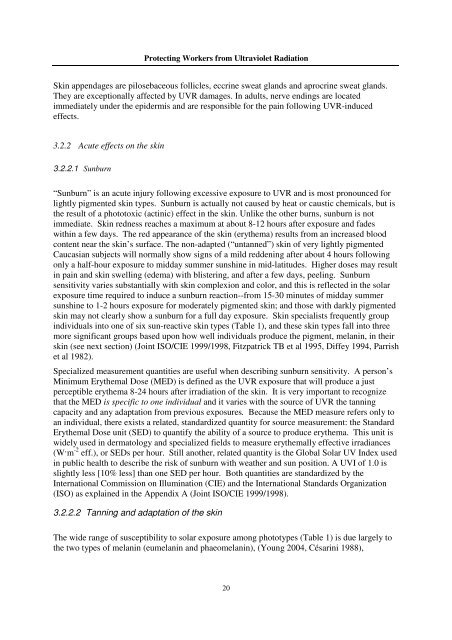Protecting Workers from Ultraviolet Radiation - icnirp
Protecting Workers from Ultraviolet Radiation - icnirp
Protecting Workers from Ultraviolet Radiation - icnirp
You also want an ePaper? Increase the reach of your titles
YUMPU automatically turns print PDFs into web optimized ePapers that Google loves.
<strong>Protecting</strong> <strong>Workers</strong> <strong>from</strong> <strong>Ultraviolet</strong> <strong>Radiation</strong><br />
Skin appendages are pilosebaceous follicles, eccrine sweat glands and aprocrine sweat glands.<br />
They are exceptionally affected by UVR damages. In adults, nerve endings are located<br />
immediately under the epidermis and are responsible for the pain following UVR-induced<br />
effects.<br />
3.2.2 Acute effects on the skin<br />
3.2.2.1 Sunburn<br />
“Sunburn” is an acute injury following excessive exposure to UVR and is most pronounced for<br />
lightly pigmented skin types. Sunburn is actually not caused by heat or caustic chemicals, but is<br />
the result of a phototoxic (actinic) effect in the skin. Unlike the other burns, sunburn is not<br />
immediate. Skin redness reaches a maximum at about 8-12 hours after exposure and fades<br />
within a few days. The red appearance of the skin (erythema) results <strong>from</strong> an increased blood<br />
content near the skin’s surface. The non-adapted (“untanned”) skin of very lightly pigmented<br />
Caucasian subjects will normally show signs of a mild reddening after about 4 hours following<br />
only a half-hour exposure to midday summer sunshine in mid-latitudes. Higher doses may result<br />
in pain and skin swelling (edema) with blistering, and after a few days, peeling. Sunburn<br />
sensitivity varies substantially with skin complexion and color, and this is reflected in the solar<br />
exposure time required to induce a sunburn reaction--<strong>from</strong> 15-30 minutes of midday summer<br />
sunshine to 1-2 hours exposure for moderately pigmented skin; and those with darkly pigmented<br />
skin may not clearly show a sunburn for a full day exposure. Skin specialists frequently group<br />
individuals into one of six sun-reactive skin types (Table 1), and these skin types fall into three<br />
more significant groups based upon how well individuals produce the pigment, melanin, in their<br />
skin (see next section) (Joint ISO/CIE 1999/1998, Fitzpatrick TB et al 1995, Diffey 1994, Parrish<br />
et al 1982).<br />
Specialized measurement quantities are useful when describing sunburn sensitivity. A person’s<br />
Minimum Erythemal Dose (MED) is defined as the UVR exposure that will produce a just<br />
perceptible erythema 8-24 hours after irradiation of the skin. It is very important to recognize<br />
that the MED is specific to one individual and it varies with the source of UVR the tanning<br />
capacity and any adaptation <strong>from</strong> previous exposures. Because the MED measure refers only to<br />
an individual, there exists a related, standardized quantity for source measurement: the Standard<br />
Erythemal Dose unit (SED) to quantify the ability of a source to produce erythema. This unit is<br />
widely used in dermatology and specialized fields to measure erythemally effective irradiances<br />
(W m -2 eff.), or SEDs per hour. Still another, related quantity is the Global Solar UV Index used<br />
in public health to describe the risk of sunburn with weather and sun position. A UVI of 1.0 is<br />
slightly less [10% less] than one SED per hour. Both quantities are standardized by the<br />
International Commission on Illumination (CIE) and the International Standards Organization<br />
(ISO) as explained in the Appendix A (Joint ISO/CIE 1999/1998).<br />
3.2.2.2 Tanning and adaptation of the skin<br />
The wide range of susceptibility to solar exposure among phototypes (Table 1) is due largely to<br />
the two types of melanin (eumelanin and phaeomelanin), (Young 2004, Césarini 1988),<br />
20



